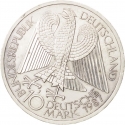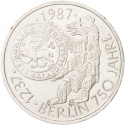You are about to finish your registration. Please check your mailbox (including spam folder). There should be a letter with a confirmation link. Check setting to make sure that your e-mail address is correct.
Send letter againDescription
Berlin is the capital and the largest city of Germany, as well as one of its 16 constituent states. First documented in the 13th century and situated at the crossing of two important historic trade routes, Berlin became the capital of the Margraviate of Brandenburg (1417–1701), the Kingdom of Prussia (1701–1918), the German Empire (1871–1918), the Weimar Republic (1919–1933) and the Third Reich (1933–1945). After World War II and its subsequent occupation by the victorious countries, the city was divided; East Berlin was declared capital of East Germany, while West Berlin became a de facto West German exclave, surrounded by the Berlin Wall (1961–1989) and East German territory. Following German reunification in 1990, Berlin once again became the capital of all of Germany.
The Rotes Rathaus (German: Red City Hall) is the town hall of Berlin, located in the Mitte district on Rathausstraße near Alexanderplatz. It is the home to the governing mayor and the government (the Senate of Berlin) of the Federal state of Berlin. The name of the landmark building dates from the facade design with red clinker bricks.
Obverse
_Mark_5/Rotes_Rathaus_1987_15.05.2018_23.03-60.jpg)
|
Depicts a national emblem of the German Democratic Republic (DDR), surrounded by the country name (above), denomination and date (below). Mintmark of the Berlin State Mint (A) is between country name and the emblem. DEUTSCHE DEMOKRATISCHE REPUBLIK |
|---|---|
Reverse
_Mark_5/Rotes_Rathaus_1987_15.05.2018_23.03_01-60.jpg)
|
Depicts the Rotes Rathaus, surrounded by the inscriptions. ROTES RATHAUS |
| Edge |
* 5 MARK * 5 MARK * 5 MARK * 5 MARK |
5 Mark
750th Anniversary of Berlin
Rotes Rathaus
Subscribe series
KM# 115
750th Anniversary of Berlin
Rotes Rathaus
Characteristics
| Type | Commemorative Issue (Circulating) |
| Material | Copper Nickel Zinc |
| Weight | 9.6 g |
| Diameter | 29 mm |
| Thickness | 2.07 mm |
| Shape |
|
| Alignment | Medal |
| Mint |
Berlin State Mint (A)
|
_Mark_5/Rotes_Rathaus_1987_15.05.2018_23.03.jpg)
_Mark_5/Rotes_Rathaus_1987_15.05.2018_23.03_01.jpg)
_Mark_5/Nikolaiviertel_1987_19.01.2019_00.22-125.jpg)
_Mark_5/Nikolaiviertel_1987_19.01.2019_00.22_01-125.jpg)
_Mark_5/Alexanderplatz_1987_12.05.2018_17.51-125.jpg)
_Mark_5/Alexanderplatz_1987_12.05.2018_17.51_01-125.jpg)

